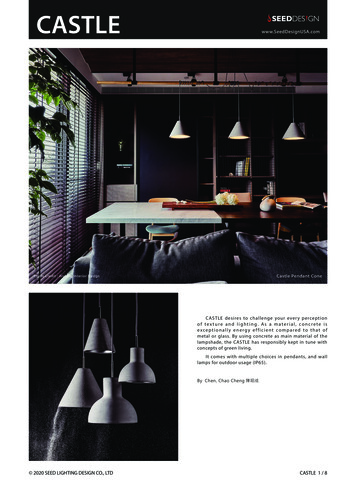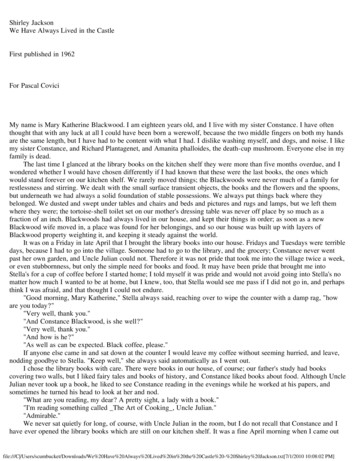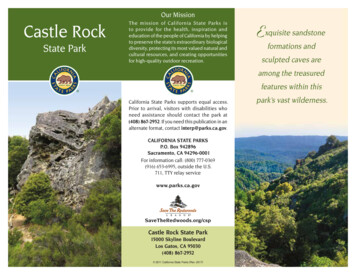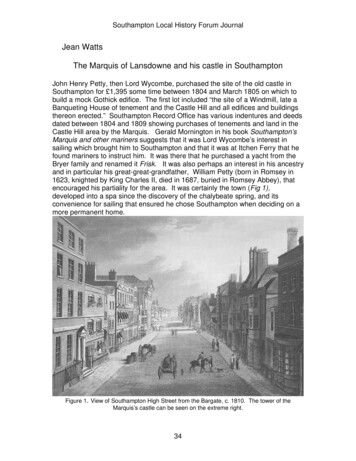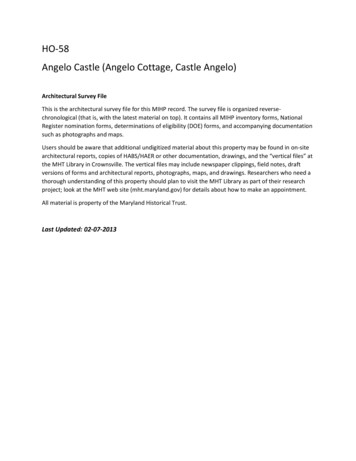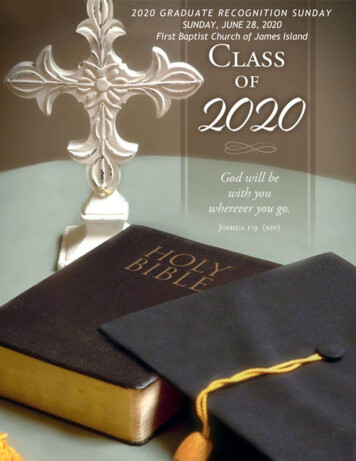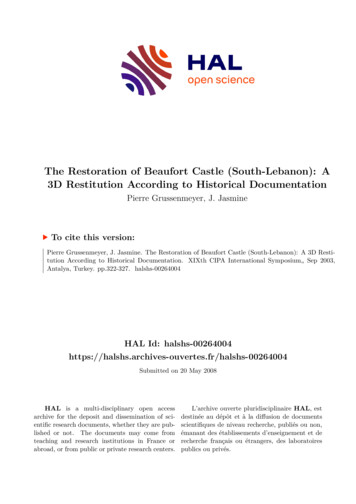
Transcription
The Restoration of Beaufort Castle (South-Lebanon): A3D Restitution According to Historical DocumentationPierre Grussenmeyer, J. JasmineTo cite this version:Pierre Grussenmeyer, J. Jasmine. The Restoration of Beaufort Castle (South-Lebanon): A 3D Restitution According to Historical Documentation. XIXth CIPA International Symposium„ Sep 2003,Antalya, Turkey. pp.322-327. halshs-00264004 HAL Id: /halshs-00264004Submitted on 20 May 2008HAL is a multi-disciplinary open accessarchive for the deposit and dissemination of scientific research documents, whether they are published or not. The documents may come fromteaching and research institutions in France orabroad, or from public or private research centers.L’archive ouverte pluridisciplinaire HAL, estdestinée au dépôt et à la diffusion de documentsscientifiques de niveau recherche, publiés ou non,émanant des établissements d’enseignement et derecherche français ou étrangers, des laboratoirespublics ou privés.
THE RESTORATION OF BEAUFORT CASTLE (SOUTH-LEBANON)A 3D RESTITUTION ACCORDING TO HISTORICAL DOCUMENTATIONPierre Grussenmeyer a, Jean Yasmine baMAP-PAGE UMR 694, National Institute of Applied Sciences, 24 Bd de la victoire, 67084 Strasbourg, Francepierre.grussenmeyer@insa-strasbourg.frbPo. Box 1019 Jounieh, Lebanon - jyasmine@beirut.comCIPA XIXth International Symposium, 30 September- 4 October 2003, Antalya, Turkey“New perspectives to save Cultural Heritage”KEY WORDS:Lebanon, Beaufort, Architectural & Archaeological heritage conservation, Photographic recording,Documentation, Archive images.ABSTRACT:This paper presents the contribution of photogrammetry within the framework of the documentation of the Beaufort castle (SouthLebanon), also called Qalaat el-Chaqif (12-17th century). After the withdrawal of the Israeli army of southern Lebanon, theLebanese government asked for a consulting firm (J. Yasmine, DGA consultant) to establish general tender documents for therestoration of the Beaufort castle. Many parts of the site were destroyed or buried because of the war.In 2002, the castle has been surveyed by geodetic methods (GPS and total station techniques) to establish reference points and arevised map of the area. In 2003, J. Yasmine has completed the survey by aerial oblique images taken by helicopter and terrestrialimages, following the recommendations of CIPA 3x3 rules. After the calibration of the different cameras, the block of images hasbeen computed within the PhotoModelerTM package, in order to document and draw the parts difficult to reach by traditionaltopographic techniques and to check the homogeneity of this important historic building (approx. surface of 150m x 75m, height of30m).Several archive images of the castle were taken by the French army between the years 1935 and 1937 (vertical and oblique overallviews on glass plates). The aim of the project is to use this archive documentation in order to try to make a 3D restitution of thedestroyed and buried historical structures of the castle. This restitution will help the consultant to establish the framework of theexcavation and restoration tasks, by showing the historical structures destroyed by the war.This collaboration has been possible thanks to the academic relations between the laboratory of photogrammetry of INSA Strasbourgand the Restoration Centre of the Lebanese University in Tripoli.RESUME :Cet article présente une contribution de la photogrammétrie dans le cadre de la documentation du château de Beaufort (Sud duLiban), également appelé Qalaat el-Chaqif (12-17ème siècle). A l’issue du retrait de l'armée israélienne du Liban méridional, legouvernement libanais a demandé à J. Yasmine, consultant pour la Direction Générale des Antiquités, d’établir une documentationdes lieux en vue de préparer l’appel d’offres de la restauration du Château de Beaufort. Plusieurs parties du site ont été détruites ouremblayées pendant la guerre.En 2002, le château a été documenté par des méthodes topographiques traditionnelles (mesures GPS et relevés tachéométriques)pour établir des points de référence et la cartographie du site. Ce relevé a été complété par J. Yasmine en 2003 par des imagesaériennes obliques prises à partir d’un hélicoptère, et des images terrestres suivant les recommandations des 3x3 règles du CIPA.L’étalonnage des appareils photos et le calcul de l’ensemble des images a été réalisé avec le logiciel PhotoModelerTM. Le calcul enbloc des différentes photos a permis de vérifier l’homogénéité des données à disposition pour ce monument (surface du sited’environ 150m x de 75m, hauteur de 30m), et de restituer et dessiner les parties difficiles à atteindre par les techniquestopographiques traditionnelles.Plusieurs images d’archives du château ont été réalisées par l'armée française entre les années 1935 et 1937 (vues d’ensembleverticales et obliques sur plaques de verre). Le but du projet est d'employer ces précieuses archives afin de produire dans lesprochains mois une restitution 3D des structures historiques détruites et enterrées du château, en vue des recherches archéologiques.Cette restitution permettra d’établir le cadre des tâches d'excavation et de restauration, en montrant les structures historiquesdétruites par la guerre.Cette collaboration a été possible grâce aux relations entre le laboratoire de photogrammétrie de l’INSA Strasbourg et le centre derestauration de l'université libanaise à Tripoli.1. INTRODUCTIONThe Fort of Beaufort is a medieval castle constructed by thecrusaders, the Ayyubids and the Mamluks. The castle is locatedin the southern part of Lebanon, a few kilometers far of theIsraeli border. It is one of the emblematic monuments attestingthe successive occupations of the site. After the Israeliwithdrawal of southern Lebanon, the Lebanese governmentcommissions a multidisciplinary team to establish a preliminarystudy for the restoration of the castle. This team is composed of
many specialists and is headed by Jean Yasmine, a consultant atthe Directorate General of Antiquities (DGA). This team isresponsible of the establishment of tender documents forcontractors. There are many works on this important monument(dimensions of the castle: 75m x 150m; height. 30m;dimensions of the surroundings: 200m x 500m). There isarchaeological excavation. There is consolidation andrestoration of structures and surfaces. There are also culturaland touristic equipment in the scope of works. The presentpaper deals with the problems of the surroundings.After the independence of Lebanon in 1943, extensive worksbegan.Lately, the castle became again a strategic stake in the war ofLebanon. Between 1976 and 1982 it was occupied by thePalestinians who attacked from this fortified point the North ofIsrael. Between 1976 and 1980, dozens of raids were made onthe castle. On June 6th, 1982, it was heavily shelled before it fellin the hands of Israelis on June 8 of that year. The destructionswe see nowadays date from that period. The Israeli army stayedthere and fortified the surroundings with bunkers and reinforcedconcrete blocks.Finally, in the year 2000, the Israeli army withdrew from thecastle after the attacks of the Lebanese resistance.3. THE THREE-DIMENSIONAL RESTITUTION ANDTHE AIM OF THE RESEARCHThe problem raised for the restitution of the historicsurroundings is the preservation of the archaeological remainswhile excavating the spoil heap dating of the war. Many ofthese archaeological remains can be seen on historicaldocumentation.3.1 The historical documentationFigure 1. Aerial view of the Beaufort castle (Nikon F3, 2003)2. HISTORIC OVERVIEW OF THE CASTLEThere is no text related to the castle before the arrival of thecrusaders. This rock crest overlooks the passage towards theSyrian hinterland. It is difficult to imagine that there was not afortified point controlling this passage before the arrival of thecrusaders.The texts say that Beaufort was deserted and taken by thecrusaders in 1139. A few years later, Beaufort was ruled by theLord of Saïda (Sagette). In the year 1179, a battle betweenBaudoin IV and Saladin took place while Renaud de Sagettewas the master of the castle. Saladin took Beaufort in 1190,after a one year siege. A few years later, before the arrival ofthe Mamluks, Al Salih Ismaïl made a deal with the crusadersand gave them the castle back in 1240. In 1260, Julien deSagette sold the castle of Beaufort to the Order of the Temple.This order kept the castle until 1268. On that date, the MamlukSultan Baibars besieged Beaufort and took it. Restorationworks and new constructions are attested in Arab texts.The 14th, 15th and 16th centuries were calm.In the 17th century, during the reign of Fakhreddine, a prince ofLebanon, the castle became part of his fortified net. After thedefeat of Fakhreddine, the ottomans destroyed the upperstructures of the castle. Between 1616 and 1769, the area wasruled by feudal families. In 1782 Al jazzar governor of cAkka(Saint Jean d'Acre) besieged the castle, took it and destroyed itsfortifications.In 1837, an important earthquake destroyed many parts of thecastle. After this date, it became a quarry for the neighborhoodand a sheep-fold.During the same period, in the late 19th century, the Orientalistscame and described the castle (successively Rey, Guérin,Conder & Kitchener). The castle was quiet in that period.After 1920, there was the French mandate on Syria andLebanon. The French emphasized on the crusader period sites.The authorities began to consolidate and to restore these castles.Many series of historical photos of the castle exist.a- Serie 1: These are the photos of the publication of PaulDeschamps (Les châteaux croisés en terre sainte, t. II, Ladéfense du royaume de Jérusalem, Ed. Geutner, Paris, 1939). Alittle part of these photos were taken by the French air force ofthe Levant between the years 1930-36. These photos are onlyavailable in the publication. The original negatives were neverfound. The use of this documentation is difficult within thescope of this project; they can only be indicative photos.b- Serie 2: These are photos still existing in the InstitutFrançais du Proche-Orient (IFPO) archives (figure 2). All thesephotos were taken by the French air force of the Levantbetween the years 1930 and 1936. We were able to getduplicates (contact prints) of the original negatives. They werethen scanned.c- Serie 3: These are photos existing in the archives of theDGA. All these photos were taken by the French air force of theLevant between the years 1931 and 1936. They are verticalviews. Only contact prints are available; the original negativeswere not found. Those contact prints were scanned.Figure 2. Example of archive photo of 1936 (IFPO), showing inthe foreground the archeological hidden remains
3.2 The modern documentationAfter the end of the war, access to the castle became secure.There was a need to manage to realize a completedocumentation of the unreachable parts of the castle (basicallythe eastern elevation over the valley). That’s why a helicopterflight was scheduled in 2003. Aerial oblique views were taken(figure 1) in that flight. They were composed of digital images(Nikon Coolpix 5000, 2560x1920 pixels) and film-based smallformat color slides (Nikon F3, Nikkor lenses, 55 mm). Last butnot least, a complete documentation requested terrestrial viewsof the castle; digital images and again film-based small formatcolor slides were taken. Thanks to this exhaustivedocumentation, three-dimensional restitution was possible. Allthe modern documentation was produced in one day.were based on these surveys. The inaccuracies of these surveysdid not represent a major problem for the restoration of thevisible areas of the castle. However, these inaccuraciesprevented us from computing the exact position of thearchaeological hidden remains. We plan to generate a newAutoCAD documentation showing the surroundings of thecastle and the archaeological hidden remains that should be dugout (§5).Figure 5. Example of 2D AutoCAD map from the tacheometricsurvey of 2002 (level 4 of the castle).Figure 3. Example of modern photo(Nikon Coolpix 5000, 2003)3.3 The topographic surveyOn that same day, while photos were being taken, a team ofgeodetic surveyors installed reference points on the ground andelevations of the castle. These points (figure 4) were easy toidentify on the photos. A total-station was used by thesurveyors to measure the reference points. This generated threedimensional coordinates for these points.Figure 6. Example of 2D AutoCAD section.4. PHOTOGRAMMETRIC DATA PROCESSING4.1 Multi-image photogrammetry3.4 The AutoCAD documentationPhotogrammetric solutions (Grussenmeyer et al., 2002) areeither based on the processing of single images (e.g. imagerectification of plane objects), stereoplottings (for stereopairs ofphotos), or multi-image restitutions when a set of convergentphotos of an object is available. The last solution has beenchosen for our project in order to process in one block the setsof photos taken from different cameras. We used thePhotoModeler software package from EOS System (Canada),well known for its applications in architecture and archaeology.The first topographic surveys conducted during the preliminarystudy were not very accurate due to the difficulties encounteredin trying to access some of the areas of the castle. These firstsurveys were performed using GPS and tacheometrictechniques. The AutoCAD maps (figures 5 and 6) used toestablish the tender documents for the restoration of the castleThe preparation steps in order to process the images were thefollowing:- definition of the “camera” file for each type of camera: the« camera calibrator » module of PhotoModeler has been used;- for the archive images, an approximate camera file has beenedited – for further “on the job calibration”;Figure 4. Examples of targets used for the reference points
- edition of the control point table (from the geodetic survey);- scan of the film or paper-based images (for the set of archiveimages and the color slides from the Nikon F3 camera).several projects) proposed in the PhotoModeler software allowsthe restitution of three-dimensional elements simultaneously onthe photographs of 1936 and 2003, and to superimpose anddisplay these results within a unique project.The basic steps in a project performed with PhotoModeler are :- choice two or more overlapping photographs from differentangles of the object ;- use the point and line tools to mark on the photographs controland tie points;- reference the points by indicating which points on differentphotographs represent the same location on the object(homologous points);- process referenced data to produce 3D model;- check the adjustment and view the resulting 3D model in the3D viewer ;- extract coordinates, distances, curves, surfaces, texturs etc.within PhotoModeler ;- export the 3D model to rendering, animation or CADprogram.4.2 Calibration of the camerasFour types of images are used for this project:- images from Nikon Coolpix 5000 in the extreme positions ofthe zoom (7mm and 21mm). This camera was calibrated in thetwo positions using the calibration grid proposed in thePhotoModeler software (module "camera calibration");- images taken with a traditional reflex camera Nikon F3,equipped with an objective Nikkor 55mm. The calibration wascarried out like previously after scanning the slides;- images of 1930-1936 scanned with a resolution of 900dpi:unfortunately no photogrammetric information on thecharacteristics of the cameras used has been found until now.Several types of glass-plates-based cameras with focal distancesof 20 to 30cm were used at that time for the acquisition of aerialand terrestrial views (Roussilhe, 1936).Figure 7a. Overview of the camera stations and the blockconfiguration after the exterior orientation4.3 Adjustment of the block of images of 2003More than 130 images were realized in spring 2003 with theNikon F3 and Nikon Coolpix cameras (a hundred images on theground and about thirty in the helicopter). A first block of 18oblique views of the castle was oriented in June 2003 using thecontrol points materialized on the ground by targets (figure 4).Standard deviations of about 10 cm on the co-ordinates of thepoints measured on the images have been obtained. We thenselected in this project ten visible points simultaneously on theimages of 1931-1936, in order to define approximations of thephotogrammetric parameters, and to calculate a block based ona selection of these archive images.4.4 Adjustment of a block of archive imagesInitially we selected 4 oblique photographs (scales of 1/1000 to1/2000) in order to document archaeological vestiges of theNorth and West parts. The approximate values of the internaland external orientations of the archive images have beencomputed within the module "process & autocalibration" ofPhotoModeler with the help of control points defined in §4.3.4.5 Merger of the two projects and preparation of therestitutionAt this stage, the two separately calculated projects are referredto the same reference system. The process of merging (ofFigure 7b. Aerial view of 1935, allowing to locate the camerastations of the figure 7a5. RESTITUTION OF THE HISTORICALSTRUCTURES NOWADAYS DISAPPEAREDFrom the block of images previously oriented, the restitutioninitially carried out in 2D in Autocad (e.g. fig. 5 and 6) will beenriched by a 3D restitution corresponding to the objectives ofthe documentation. We are then able to calculate and draw thevisible structures on the aerial and terrestrial photographs of2003 by digitalizing on the images (fig. 8).One will proceed in an identical way on the archivephotographs to measure the archaeological structures currentlycovered by the remains of the war, or to plot in 3D parts of thecastle currently embanked or destroyed (fig. 9).
Figure 8. Multi-image restitution within PhotoModeler 5.0Figure 9. Restitution of the embankment areas.On the left, the boundary of the embankment is marked on a photo of 2003 and on the right, the corresponding surface is projectedon an archive photo of 1936The superposition of the two restitutions make it possible tohighlight the areas of interest (figures 9 and 10) forarchaeological work and to estimate work of civilengineering (fill, cubature, rebuilding, etc).Moreover, the restitution of the site in wire frame and surfacemodel can be supplemented by the addition of texturescoming either from the images of 1936, or of those of 2003.From the resulting 3D photomodels, orthophotos can becalculated for the two periods, as e.g. for the frontages of thecastle or the installations around the site covering thearchaeological structures (fig. 11).
19362003Figure 10. Archaeological structures are measured on the archive images of 1936 and the corresponding surface is shown on thephotos of 2003géographique et monumentale, vol. "Album", BibliothèqueArchéologique et Historique, Tome XXXIV, Paris, LibrairieOrientaliste Paul Geuthner, Plate LV.Grussenmeyer, P., Hanke, K., Streilein, A., 2002. Architecturalphotogrammetry. Chapter in « Digital Photogrammetry ».Edited by M. Kasser and Y. Egels, Taylor & Francis, pp. 300339.Huot, J.-L., Salem Kardous, A., 2001. Photographies du Levant.Institut Français d’Archéologie du Proche-Orient, Beyrouth,Liban, 165 pages.Figure 11. Example of orthophoto of the archeological structure(computed from archive images)6. CONCLUSIONThis project has shown the importance of photogrammetrywithin the framework of 3D documentation of the castle ofBeaufort, for the development of the site and the landscape.The study presented in this paper shows that using the old aerialphotographs taken by French air force of the Levant between1931 and 1936, a comparative restitution makes it possible tolocate in a precise way the visible archaeological structures onthe archive photographs. Only a small part of the site wascurrently plotted with these techniques. This study will besupplemented in the next months by the completephotogrammetric restitution of the whole set of photographscarried out in April 2003. The contractor who will be in chargeof the restoration will then have all information to release thegreat quantity of fill around the castle, in order to preserveintact the historical and archaeological structures which wouldbe still in-situ below the embankment.7. REFERENCESReferences from Journals:Grussenmeyer, P., 2003. Photogrammétrie architecturale etmodélisation 3D du patrimoine. Revue de l’AssociationFrançaise de Topographie, 2e trim. 2003, N 95, p.30-36.References from Books:Deschamps, P., 1939. Les Châteaux des Croisés en Terre SainteII: La Défense du Royaume de Jérusalem, étude historique,Philipson, W.R. (Editor), 1997. Manual of PhotographicInterpretation, 2nd Edition. Edited by the American Society forPhotogrammetry and Remote Sensing, Bethesda, Maryland, 689pages.Roussilhe, H., 1936. La photogrammétrie et ses applicationsgénérales, Tomes 1 et 2. Encyclopédie industrielle etcommerciale, Librairie de l’enseignement techniques, L.Eyrolles (Paris).References from Other Literature:Bessac J.-C. et Yasmine J., 2001. Etude préliminaire deschantiers de construction du château de Beaufort, in BAAL, N 5,p.241-320.8. ACKNOWLEDGEMENTSThe authors would like to thank Ghassan Salame Minister ofCulture of the Lebanese Republic and Frederic HusseiniGeneral Director of Antiquities for their help in organizing thehelicopter flight.The authors would like also to thank Jean-Louis Huot, AlmaKardous (IFPO) and Anne Marie Afeiche (DGA) for their helpin providing the historical documentation.The authors finally thank Mrs. Rawya Majzoub Barake,Director of the Center of restoration from the LebaneseUniversity in Tripoli to have allowed and encouraged theorganization of an introductory course in architecturalphotogrammetry in the diploma of specialized studies ofrestoration and conservation of monuments and historic sites inTripoli, within the framework of the French-Lebanesecooperation. It was under these circumstances that the authorsallowed to meet in 1998.
Several archive images of the castle were taken by the French army between the years 1935 and 1937 (vertical and oblique overall views on glass plates). The aim of the project is to use this archive documentation in order to try to make a 3D restitution of the destroyed and buried historical structures of the castle.

